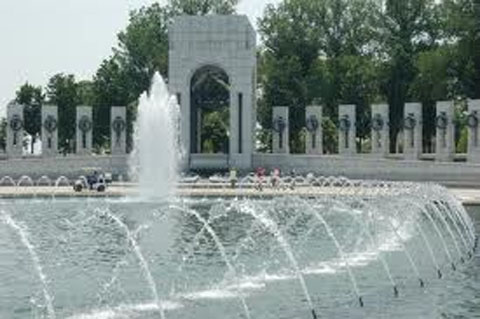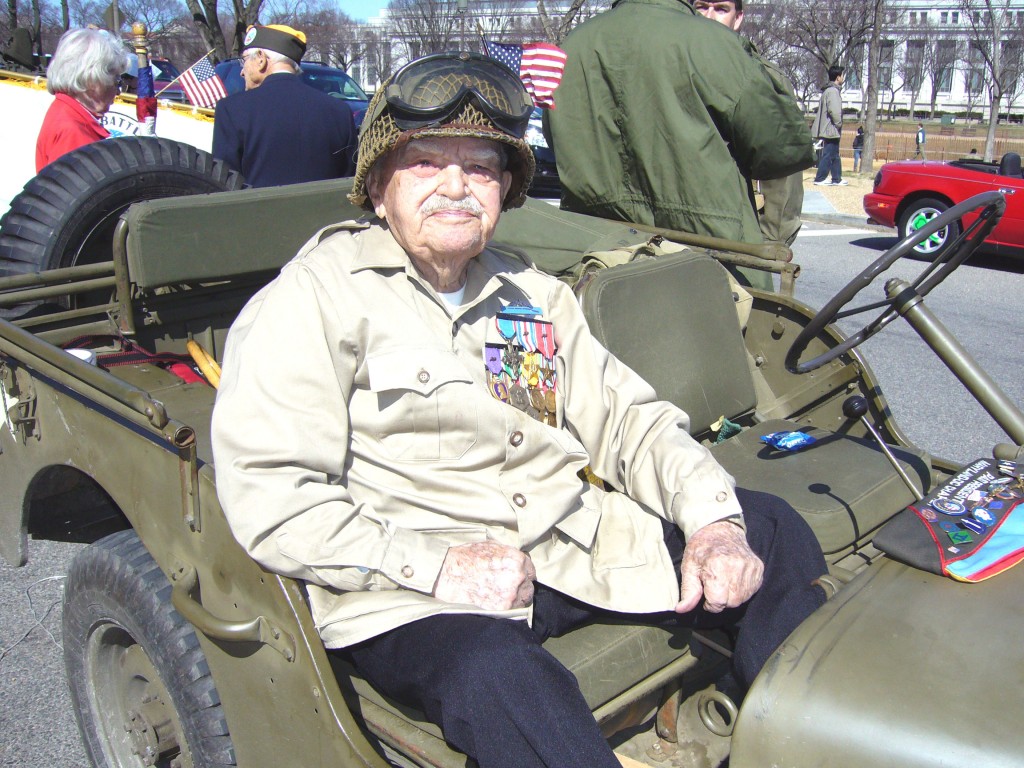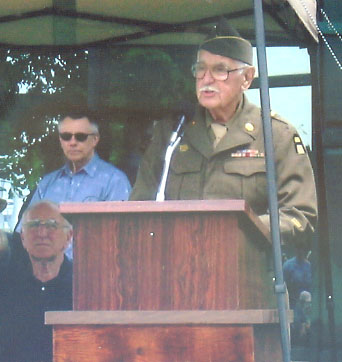
The World War II Memorial in Washington DC is a beautiful and solemn tribute to all who served their country during World War II. Veterans, have you been to the World War II Memorial in Washington DC?
If not click here

The World War II Memorial in Washington DC is a beautiful and solemn tribute to all who served their country during World War II. Veterans, have you been to the World War II Memorial in Washington DC?
If not click here

Edward Richard Radzwich, the designer of our Veterans of the Battle of the Bulge Certificate, died unexpectantly, under his magnolia tree on 9 July 2011. Ed conceived the design of the beautiful VBOB certificate on the back of a long Japanese calendar. Ed, faced with the dilemma of over 2,000 units that received the Ardennes Campaign credit and how to represent them, decided that each soldier in his unit would have had to have been attached to one of the major units (12th Army Group, or First, Third or First Allied Airborne Armies, or six Corps, or 33 Divisions or the units of the Eighth or Ninth Air Forces that supported the Bulge).
Thus, Ed took to cutting and pasting small copies of these major unit patches that fought in the Bulge and the flags of the United States, Belgium and Luxembourg. Photos from the National Archives Signal Corps Photo Collection to illustrate the harshness of the weather and the trudging through the forests satisfied with the concept and the wording it was turned over to a graphics artist and design company to finalize the design and prepare the artwork for printing. To date 8,000 of these Certificates have purchased by Bulge Veterans or their families in the Bulge Veterans name. The Veterans of the Battle of the Bulge are indeed indebted to Ed Radzwich for this Certificate of recognition for those who served in the Battle of the Bulge.
Ed Radzwich was born into a coal miner’s family in West Hazleton PA. He was an active Boy Scout, attaining the rank of Eagle Scout. A gifted high school graduate in the depression era and unable to afford further education, he saw the United States Army as his opportunity. He enlisted as a Private in May 1934 in the Chemical Corps. He completed service but was recalled from the Reserves in Feb 1941. Ed was selected to be one of the first groups of enlisted men to attend the new Officer Candidate School under BG Omar Bradley, at Fort Benning GA. Ed was being fitted at the tailors in Columbus GA, for his “Pinks & Greens,” Officer’s Dress uniform, when the news came over the radio that Pearl Harbor had been attacked, He graduated Infantry Officer Candidate School (OCS) class 41-3, one week after Pearl Harbor, Class 41-3 with a 2nd Lieutenant’s Commission.
He was assigned to the 26th Infantry (Yankee) Division, at Camp Edwards, Massachusetts, that December 1941, at the time when most of the unit was given leave for the Holiday’s. As a newly minted 2nd Lt, Ed was assigned as officer-in-charge of most everything on the post since virtually all of the National Guard officers had taken leave. Ed, undaunted, using his intellect and initiative, rose to the occasion, and performed in a superior way with little of no guidance. This was to become a hallmark of his service. He was to be as one of the first Ranger trainees to attend the First Ranger School, Camp Forrest, Tullahoma, Tennessee, in early 1943, where he graduated as a Ranger in the First Ranger Class. Ed was to remain with the “Yankee” Division throughout WWII advancing to Captain and Company Commander, I Company, 101st Infantry Regiment, prior to the unit leaving the states for combat.
Ed was one of the few company commanders to go into combat as a Company Commander and to come out of the war with the same company, which he led through the Campaigns of Northern France, Rhineland, the Battle of the Bulge (Ardennes) and central Europe. He was given R&R leave from Fulda Germany just before May 1945 and celebrated VE Day in New York City with his wife, Mary.
Ed was an outstanding Company Commander as attested to by his men, always leading from the front. For his heroic actions in combat he received the Distinguished Service Cross, Silver Star with two Oak Leaf Clusters, Bronze Star with two Oak Leaf Clusters, and Purple Heart with two Oak Leaf Clusters. He also received two awards of the Army Commendation Medal. He was most proud of his Combat Infantryman Badge. Ed was a true hero.
After the war he was offered a Regular Army commission on 5 Jul 1946. He was assigned to US Military Government in Korea Jul 1946 – June 1949 and because of his six month’s experience, as a youth, working in a coal mine in Pennsylvania, he was put in charge of all the coal mines in Korea. He also served as Army Instructor, NJ National Guard Sept 1949-May 1951; Battalion Commander 33 RCT, Panama Canal Zone, Jul 52 – Jan 1955; Chief of Civil Affairs, Assistant Chief of Staff G-5, Eighth Army, Korea, Feb 1957 – Jun 1958; and G-3, Second US Army, Reserve Components, Fort George G. Meade, Jul 58 – Feb 1961. He retired as a Lieutenant- Colonel in Mar 1961 with 25 years of service.
On August 8, 2003 Edward Radzwich lost his beloved wife, Mary. They had been married 64 years. He is survived by three children, Gloria, Virginia and Edward Jr., two grandchildren and three great grandchildren.
Honors & Citations:
Distinguished Service Cross, Silver Star w/2 Oak Leaf Clusters, Bronze Star w/2 Oak Leaf Clusters, Purple Heart w/2 Oak Leaf Clusters, Army Commendation Medal w/ Oak Leaf Cluster, Combat Infantryman Badge, Presidential Unit Citation. Installed in Infantry OCS Hall of Fame, Ft Benning, GA, March 1959. For his outstanding contributions and decorations as a soldier, LTC Edward R. Radzwich was elected to membership in the prestigious Legion of Valor. He served our country with great distinction. He was an outstanding patriot.
Sources: Michael Samberg, who served as an enlisted man under Captain Radzwich during WWII and John D. Bowen, VBOB Recording Secretary.
Monument Dedicated May 31, 2011
Military park unveils new memorial for Battle of the Bulge
by Kevin Allen, South Bend Tribune Staff Writer
Photos by Robert Franklin South Bend Tribune
Former British Prime Minister Winston Churchill called it “undoubtedly the greatest American battle” of World War II and an event he believes would “be regarded as an ever famous American victory.” It was the Battle of the Bulge – 40 days of fighting in the bitter cold of December 1944 and January 1945 to force the German army out of Belgium and Luxembourg in what was Adolf Hitler’s last best chance to turn the tide against the allies.
The American triumph over the Nazi onslaught led the way to victory in Europe the following spring and now the Battle of the Bulge is memorialized at the Military Honor Park and Museum next to South Bend Regional Airport. Park and museum officials hosted a ceremony Monday afternoon to unveil a granite monument dedicated to the 600,000 US soldiers who fought in the bloodiest American battle of World War II.
One of those US soldiers, Geza Csapo, of Osceola donated money for the monument. Csapo, 85 served in the Army from 1943 to 1945 and fought in tanks during the Battle of the Bulge. “This is a much-needed addition to the park”, he said of the monument “I dread to think what the world would be like today if the Germans had won”. Csapo said he was caught by surprise when the German attack began December 16, 1944. There wasn’t much time to think about the significance of the battle. All I remember he said “it is early one morning night turned into day”.
Frank Firtl a Mishawaka resident who worked in intelligence and reconnaissance for the Army during the Battle of the Bulge said the sky that morning looked like Disneyland on the Fourth of July.
Csapo came close to dying during the battle as a German soldier aimed a bazooka at his tank. Fortunately for Csapo he fired a shot before us German soldier did. Firtl, 94 also had several close calls as he moved behind enemy lines as a scout. He suffered a fractured skull and a blown out eardrum later in the war when the jeep he was riding in hit a land mine in Germany.
Louis Kobold another Mishawaka resident who fought in the Battle of the Bulge wasn’t able to witness the monument’s dedication Monday, he died in December 2009. Kobold’s family however was on hand for the event. I am sure he’s looking down and smiling at what happened here today his son Mark said. Louis Kobold nearly lost his feet to frostbite at the Battle of the Bulge and as a result he had trouble with his feet for the rest of his life. He also suffered a shrapnel injury there and slivers of metal continued surfacing in his hip for years after. His widow Dorothy said he kissed the ground when he returned to Mishawaka. But he never talked about the war he just hoped his children would never have to experience anything like it. They just want to come home get married and have children Dorothy Kobold said of the World War II veterans. They wanted to have a normal life because war was never normal.
Csapo said he reacted similarly when he returned stateside. I never said a word he said my children didn’t even know I was in the war until they were grown. But after talking about his experiences on a canoe trip in Michigan he said the stories poured out as if a damn had broken. Csapo quickly found it was important and therapeutic to pass on the history. With the new monument his contribution to keep that history alive will be permanent.

The Gateway Chapter was pleased to have a visit of a number of delegates from the Moscow School of Political Studies at the May meeting. The Russian visitors met with about 25 members to thank them for their service in World War II and hear their recollections of meeting Russian soldiers during the war. To honor V-E Day (May 8), the Russian delegates presented the Chapter with an evergreen tree, which was planted near the Battle of the Bulge Monument and WWII GI Statue in Jefferson Barracks Park a few days later.
The Russian delegates were llya V. Savchenko, Timur Botvin, Roman Ryabintsev, Georgy Kaytukov, Magomed Magomedomarov and Natalya Paleeva.The veterans, in return, gave the delegates a copy of our book, “Victory Through Valor: A Collection of World War II Memoirs,” and a photo of the Battle of the Bulge Monument and World War II GI Statue. The visit by the Russian group was through the auspices of the University of Missouri–St. Louis’ Center for International Studies and coordinated by Professor Jerol Enoch.
Photos by August Jennewein/UMSL
Veterans in above photo: Ray Saul (4th Infantry Division), Dick Cotter (26th Infantry Division)
Bernie Schwender (78th Infantry Division), Richard Coyle (28th Infantry Division)
Billy Stiegemeier (87th Infantry Division), Barny Baker (328th Fighter Control Squadron)
President Kent Stephens (26th Infantry Division), Don Green (106th Infantry Division)
Clyde Erb (26th Infantry Division), Eugene Ganz (1st Infantry Division)
Glen Jarvis (467th AAA AW), Marvin Korte (84th Infantry Division)
Ralph Forys (26th Infantry Division), Stanley Gibson (99th Infantry Division)
Harold Mueller (110th AAA 90MM MBL), Rusty Pendleton (11th Armored Division)

Pankop recounts combat experience at Battle of the Bulge
By Danielle Smith, The Paper-Wabash, IN – June 1, 2011
Gerald Pankop, 85, is one of the lucky men that returned home after spending time in combat at the Battle of the Bulge in Belgium during World War II. After being injured by a mortar, he was honored with the Purple Heart and Bronze Star for his bravery and sacrifice. Pankop voluntarily enlisted at 18 years old in 1944. “They rushed me through training and sent me over to the Battle of the Bulge,” Pankop said. “They needed men because they were losing so many.” Pankop entered the First Army, 99th Division, 393rd Infantry, as a buck private and came out as a private first class. He explained that part of the reason he moved through the ranks so quickly is because they were losing soldiers at such an alarming rate.
“There are 2,000 men in a regiment, we lost about half of our men,” he said. Pankop credits his survival to his short stature. He was offered an opportunity to make sergeant, but that would have required him to move to the front of the platoon. Surprisingly, the officer allowed him to decline the offer, which earned him the right to stay in his safer position in the back. “I was short so I was always in the back, sergeants are up front in danger,” he explained. Short men were placed in the rear of the platoon because they tend to walk more slowly. “That’s probably what saved my life is being in the back all the time.”
During his time in Belgium, Pankop only received three hot meals, two of which were boxed meals. The third was on Christmas Eve. An officer sent Pankop and other men to a church where they were served a full Christmas dinner, complete with steak and mashed potatoes. Following the meal, Pankop complimented the cook. “I said ‘That’s the best meal I’ve had for I don’t know how long’, and the cook said ‘Oh, you like horse meat, huh?,” Pankop recounted. A disbelieving Pankop looked behind the church where he was greeted with the sight of the heads, skin and bones of the horses they had just consumed.
Pankop also recalled seeing a steam-powered truck traveling up a hill in Belgium. The truck had wooden wheels and a boiler in the back to contain the fire that powered it. Pankop and his companions watched as the driver exited the truck and threw more wood on the fire to allow the truck to continue up the hill. “I said ‘Man, we don’t have anything like that back home,” he recalled.
During Pankop’s time in Belgium, they slept in snowdrifts and never had an opportunity to change their clothes. He was there in December during intense combat. He recalled an instance where he and some comrades were standing nearby while some , searched a recently captured German bunker in the ground. “There were seven or eight of us standing outside leaning on our rifles and the Germans threw a big mortar shell in there and it knocked all of us on the ground. I had two phosphorous grenades and it knocked the bottom off of one of them. Phosphorous burns you something terrible, you can’t hardly stop it. I was laying there and I hurt so bad I couldn’t even throw it away and I kept hollering for someone to come get it. Finally one guy did come over and grab it and throw it as hard as he could,” he recounted. “After things quieted down a little bit the medics came up and they only took two us and left the rest of them lay.”
After 30 days in combat, Pankop returned home. “There’s a Henri- Chapelle Cemetery in Belgium that has 9,000 of our troops that got a Purple Heart but didn’t get to come home. I don’t know why but I think of that so often. I guess I just got a little blessing along the way and I got to come home and get married and raise four children,” he said. Much of Pankop’s war memorabilia is on display in the Northfield Jr./Sr. High School’s library.